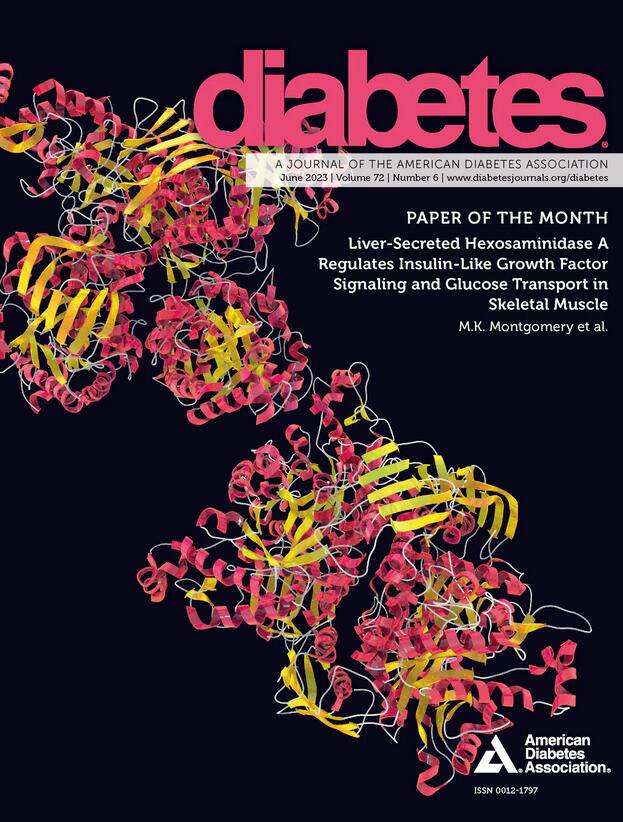Revealing Cerebral Microvascular Changes in Diabetic Rodents With Ultrasound Localization Microscopy
IF 7.5
1区 医学
Q1 ENDOCRINOLOGY & METABOLISM
引用次数: 0
Abstract
Microvasculature and hemodynamic changes in the cerebrovascular system are valuable indicators for the investigation of diabetic cerebrovascular disease. However, it is challenging for conventional imaging techniques to capture these minute features, meaning that the specific effects of diabetes on the brain vasculature and its potential disruption of brain function remain inadequately investigated. Ultrasound localization microscopy, with its unprecedented subdiffraction resolution and microvascular sensitivity, enables previously unobserved subtle variations to be revealed. Here, we aimed to leverage this advanced imaging technology to explore the alterations of brain in a diabetic rodent model in vivo. Parallel comparisons were made between diabetic rats and age-matched controls, and longitudinal assessments were performed before and after development of diabetes. In parallel comparisons, we found that rats with diabetes had significantly reduced vascular density in several key brain regions, including the striatum (13.70%), basal forebrain (8.48%), thalamus (12.20%), hypothalamus (20.85%), and hippocampus (8.73%). These findings were further supported by vascular staining and high-field MRI results. In addition, we demonstrated that a slowing of blood flow could be observed in the above brain regions. These results pave the way to understanding the effects of diabetes on the cerebral vasculature and may enable the future development of therapeutic and intervention strategies for diabetic cerebrovascular lesions. ARTICLE HIGHLIGHTS Cerebral microvascular disease can be triggered in people with diabetes who have chronic hyperglycemia. The aim of our study was to understand what effect diabetes has on the cerebral vasculature. In a rodent model, diabetes caused varying degrees of reduced cerebral vascular density and slowed cerebral blood flow in the brain striatum, basal forebrain, thalamus, hypothalamus, and hippocampus. There is a correlation between vessel density and blood flow velocity and the correlation changes in the diabetic state.用超声定位显微镜观察糖尿病啮齿动物的大脑微血管变化
脑血管系统微血管和血流动力学变化是糖尿病性脑血管病的重要指标。然而,传统的成像技术很难捕捉到这些细微的特征,这意味着糖尿病对脑血管系统的具体影响及其对脑功能的潜在破坏仍然没有得到充分的研究。超声定位显微镜,以其前所未有的亚衍射分辨率和微血管灵敏度,使以前未观察到的细微变化得以揭示。在这里,我们旨在利用这种先进的成像技术来探索糖尿病啮齿动物模型体内的大脑变化。在糖尿病大鼠和年龄匹配的对照组之间进行平行比较,并在糖尿病发生前后进行纵向评估。在平行比较中,我们发现糖尿病大鼠的几个关键脑区血管密度显著降低,包括纹状体(13.70%)、基底前脑(8.48%)、丘脑(12.20%)、下丘脑(20.85%)和海马(8.73%)。血管染色和高场MRI结果进一步支持了这些发现。此外,我们证明在上述脑区可以观察到血流减慢。这些结果为了解糖尿病对脑血管系统的影响铺平了道路,并可能为未来糖尿病脑血管病变的治疗和干预策略的发展奠定基础。慢性高血糖的糖尿病患者可诱发脑微血管疾病。我们研究的目的是了解糖尿病对脑血管系统的影响。在啮齿动物模型中,糖尿病导致不同程度的脑血管密度降低,脑纹状体、基底前脑、丘脑、下丘脑和海马的脑血流量减慢。血管密度与血流速度之间存在相关性,糖尿病状态下相关变化。
本文章由计算机程序翻译,如有差异,请以英文原文为准。
求助全文
约1分钟内获得全文
求助全文
来源期刊

Diabetes
医学-内分泌学与代谢
CiteScore
12.50
自引率
2.60%
发文量
1968
审稿时长
1 months
期刊介绍:
Diabetes is a scientific journal that publishes original research exploring the physiological and pathophysiological aspects of diabetes mellitus. We encourage submissions of manuscripts pertaining to laboratory, animal, or human research, covering a wide range of topics. Our primary focus is on investigative reports investigating various aspects such as the development and progression of diabetes, along with its associated complications. We also welcome studies delving into normal and pathological pancreatic islet function and intermediary metabolism, as well as exploring the mechanisms of drug and hormone action from a pharmacological perspective. Additionally, we encourage submissions that delve into the biochemical and molecular aspects of both normal and abnormal biological processes.
However, it is important to note that we do not publish studies relating to diabetes education or the application of accepted therapeutic and diagnostic approaches to patients with diabetes mellitus. Our aim is to provide a platform for research that contributes to advancing our understanding of the underlying mechanisms and processes of diabetes.
 求助内容:
求助内容: 应助结果提醒方式:
应助结果提醒方式:


